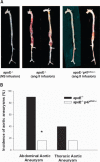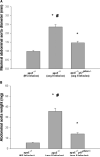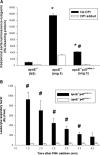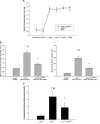Deletion of p47phox attenuates angiotensin II-induced abdominal aortic aneurysm formation in apolipoprotein E-deficient mice
- PMID: 16864727
- PMCID: PMC3974117
- DOI: 10.1161/CIRCULATIONAHA.105.607168
Deletion of p47phox attenuates angiotensin II-induced abdominal aortic aneurysm formation in apolipoprotein E-deficient mice
Abstract
Background: Angiotensin II (Ang II) contributes to vascular pathology in part by stimulating NADPH oxidase activity, leading to increased formation of superoxide (O2-). We reported that O2- levels, NADPH oxidase activity, and expression of the p47phox subunit of NADPH oxidase are increased in human abdominal aortic aneurysms (AAAs). Here, we tested the hypothesis that deletion of p47phox will attenuate oxidative stress and AAA formation in Ang II-infused apoE-/- mice.
Methods and results: Male apoE-/- and apoE-/-p47phox-/- mice received saline or Ang II (1000 ng x kg(-1) x min(-1)) infusion for 28 days, after which abdominal aortic weight and maximal diameter were determined. Aortic tissues and blood were examined for parameters of aneurysmal disease and oxidative stress. Ang II infusion induced AAAs in 90% of apoE-/- versus 16% of apo-/-p47phox-/- mice (P < 0.05). Abdominal aortic weight (14.1 +/- 3.2 versus 35.6 +/- 9.0 mg), maximal aortic diameter (1.5 +/- 0.2 versus 2.4 +/- 0.4 mm), aortic NADPH oxidase activity, and parameters of oxidative stress were reduced in apoE-/-p47phox-/- mice compared with apoE-/- mice (P < 0.05). In addition, aortic macrophage infiltration and matrix metalloproteinase-2 activity were reduced in apoE-/-p47phox-/- mice compared with apoE-/- mice. Deletion of p47phox attenuated the pressor response to Ang II; however, coinfusion of phenylephrine with Ang II, which restored the Ang II pressor response, did not alter the protective effects of p47phox deletion on AAA formation.
Conclusions: Deletion of p47phox attenuates Ang II-induced AAA formation in apoE-/- mice, suggesting that NADPH oxidase plays a critical role in AAA formation in this model.
Figures







References
-
- Ashton HA, Buxton MJ, Day NE, Kim LG, Marteau TM, Scott RA, Thompson SG, Walker NM. The Multicentre Aneurysm Screening Study (MASS) into the effect of abdominal aortic aneurysm screening on mortality in men: a randomised controlled trial. Lancet. 2002;360:1531–1539. - PubMed
-
- Shah PK. Inflammation, metalloproteinases, and increased proteolysis: an emerging pathophysiological paradigm in aortic aneurysm. Circulation. 1997;96:2115–2117. - PubMed
-
- Freestone T, Turner RJ, Coady A, Higman DJ, Greenhalgh RM, Powell JT. Inflammation and matrix metalloproteinases in the enlarging abdominal aortic aneurysm. Arterioscler Thromb Vasc Biol. 1995;15:1145–1151. - PubMed
-
- Newman KM, Jean-Claude J, Li H, Ramey WG, Tilson MD. Cytokines that activate proteolysis are increased in abdominal aortic aneurysms. Circulation. 1994;90(suppl II):II–224–II-227. - PubMed
-
- Zimmerman MC, Lazartigues E, Sharma RV, Davisson RL. Hyper-tension caused by angiotensin II infusion involves increased superoxide production in the central nervous system. Circ Res. 2004;95:210–216. - PubMed
Publication types
MeSH terms
Substances
Grants and funding
LinkOut - more resources
Full Text Sources
Other Literature Sources
Molecular Biology Databases
Miscellaneous

